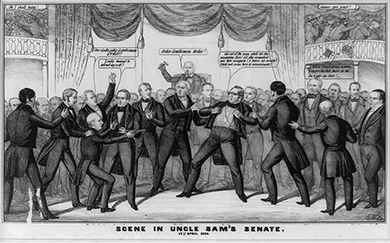| << Chapter < Page | Chapter >> Page > |
Clay’s proposals ignited a spirited and angry debate that lasted for eight months. The resolution calling for California to be admitted as a free state aroused the wrath of the aged and deathly ill John C. Calhoun, the elder statesman for the proslavery position. Calhoun, too sick to deliver a speech, had his friend Virginia senator James Mason present his assessment of Clay’s resolutions and the current state of sectional strife.
In Calhoun’s eyes, blame for the stalemate fell squarely on the North, which stood in the way of southern and American prosperity by limiting the zones where slavery could flourish. Calhoun called for a vigorous federal law to ensure that runaway slaves were returned to their masters. He also proposed a constitutional amendment specifying a dual presidency—one office that would represent the South and another for the North—a suggestion that hinted at the possibility of disunion. Calhoun’s argument portrayed an embattled South faced with continued northern aggression—a line of reasoning that only furthered the sectional divide.
Several days after Mason delivered Calhoun’s speech, Massachusetts senator Daniel Webster countered Calhoun in his “Seventh of March” speech. Webster called for national unity, famously declaring that he spoke “not as a Massachusetts man, not as a Northern man, but as an American.” Webster asked southerners to end threats of disunion and requested that the North stop antagonizing the South by harping on the Wilmot Proviso. Like Calhoun, Webster also called for a new federal law to ensure the return of runaway slaves.
Webster’s efforts to compromise led many abolitionist sympathizers to roundly denounce him as a traitor. Whig senator William H. Seward, who aspired to be president, declared that slavery—which he characterized as incompatible with the assertion in the Declaration of Independence that “all men are created equal”—would one day be extinguished in the United States. Seward’s speech, in which he invoked the idea of a higher moral law than the Constitution, secured his reputation in the Senate as an advocate of abolition.
The speeches made in Congress were published in the nation’s newspapers, and the American public followed the debates with great interest, anxious to learn how the issues of the day, especially the potential advance of slavery, would be resolved. Colorful reports of wrangling in Congress further piqued public interest. Indeed, it was not uncommon for arguments to devolve into fistfights or worse. One of the most astonishing episodes of the debate occurred in April 1850, when a quarrel erupted between Missouri Democratic senator Thomas Hart Benton, who by the time of the debate had become a critic of slavery (despite owning slaves), and Mississippi Democratic senator Henry S. Foote. When the burly Benton appeared ready to assault Foote, the Mississippi senator drew his pistol ( [link] ).


Notification Switch
Would you like to follow the 'U.s. history' conversation and receive update notifications?